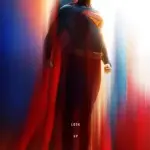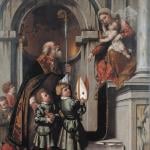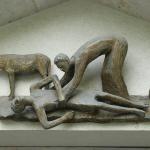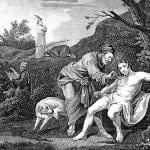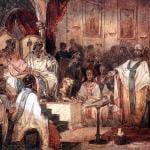UNITY AND VOCATION: Last week, while looking for something else, I came upon a file folder of my old school essays. (College and, in two cases, high school.) Some of them are dumb or juvenile or both, but some of them are still pretty interesting; so I figured I’d post excerpts in case you all are interested. These are abridged but otherwise uncorrected. I’ve indicated notes from my instructors in brackets, and any links should go to posts I think relate somehow to the subject of the paper. So, let’s start with “Duality and Complexity in The Faerie Queene.” Yay for Spenser, he’s supercool even though I never have been able to fight my way through the entire poem.
——————————————————————————————
Throughout Book I of The Faerie Queene, Spenser returns to the theme of duality and multiplicity. He does this most often and most obviously when presenting an evil character; his allegorical villains disguise themselves, create doubles of other characters, or embody multiplicity as many offspring or several brothers. In this way he presents truth and virtue as whole, holy, and one, as reflected in Una’s name, and evil as manifold, a throng of falsehoods masquerading as truths. However, Spenser also provides instances where duality does not represent evil, and it is significant that he ends with the separation of Una and her knight. The theme of the multiplicity of evil is most clearly stated in the beginning and middle of the poem, with counterexamples of “good twins” coming in toward the end. These examples complicate the poem, suggesting that although there is one truth, there is more than one way to pursue it. Arthur’s way, though virtuous, is not Redcrosse Knight’s; that is why he cannot perform the task Redcrosse was set.
The poem begins with the unsettling contrast between Redcrosse’s armor, with its “old dints of deepe wounds,” and the fact that “armes till that time did he never wield” (I.i.1.1-5). Redcrosse at this moment has a dual nature, and although we do not get a sense that he is evil, we can see that he has not yet been tested and may not be entirely virtuous. …In this canto Redcrosse’s duality foreshadows both his beguilement by Archimago and his enthrallment to Duessa, whereas Una’s wholeness signals us that she will remain innocent and virtuous despite her trials.
Throughout the beginning of the poem, evil is presented as dual, multiple, or shape-shifting. Errour, half woman and half snake, and her “thousand yong ones” (I.i.15.5) are the first of the Redcrosse Knight’s attackers; later we meet the three brothers Sansfoy, Sansjoy, and Sansloy. Archimago, the “arch-mage” and “arch-image,” of course creates false images. He changes his shape, and creates a false counterpart for Una as well as making himself into Redcrosse’s evil twin. …
By the time the knight arrives at the cave of Despair, however, the representations of good and evil have already begun to change somewhat. The knight’s three great opponents of the middle and end of the poem aare all singular: Orgoglio, Despair, and the Dragon. Meanwhile, a creature which is dual in nature and yet not evil has appeared, and a second knight has arrived as well. Satyrane and Arthur in many ways take up the role of foil for Redcrosse Knight where Archimago left off; their different characters reflect the changes in Redcrosse’s character. He moves from the false appearance which he shared with Archimago to the good instincts but untutored, undisciplined nature of Satyrane, and from there to the truly virtuous and devoted knighthood represented by Arthur. …
Arthur is another matter. …Yet even in this first appearance there are strange hints that if evil can mimic good, perhaps good can mimic evil. The symbolism of his armor with its luxury, his crest “discoloud diversly” (I.vii.32.2) like that of Archimago’s false Redcrosse Knight, and especially the dragon on his helmet at first may lead the reader to mistrust Arthur. …The fact that these misgivings are not borne out shows a subtlety of characterization greater than Satyrane’s but related to his character, for Spenser is suggesting even more strongly that a virtuous nature can transmute elements which seemed evil into forces for good. …In the world of the Faerie Queene, everyone has a role to fulfill, and people may take different paths to the good. …
…The book’s ending presents us with a paradox if we read it as we would have read the beginning, since in I.xii.41 virtuous action actually separates a “blisfull” union. Spenser has moved away from his earlier, clear-cut associations of duality with evil and unity with good. By the end of Book I, we see that imperfection (Satyrane’s wild nature) can be used for good ends; that just as villains can use the symbols of faith and truth (“this false woman, that Fidessa hight,” I.xii.32.2), so heroes can use symbols associated with evil; that there are many forms of righteous action, as represented not just by Arthur and Redcrosse but also by the many different inhabitants of the House of Holiness; and that even these righteous actions can have temporarily sad effects. Although his use of allegorical figures and names such as “Una” and “Duessa” seem on the surface extremely simple, that surface, like so many in Book I, hides a much more complex reality.






